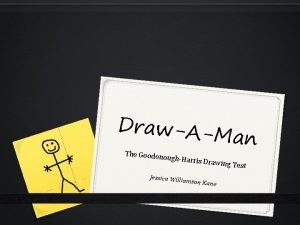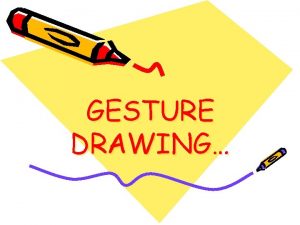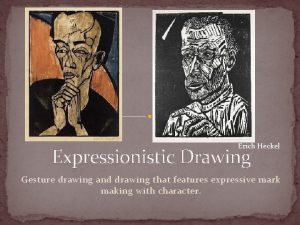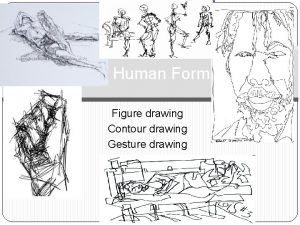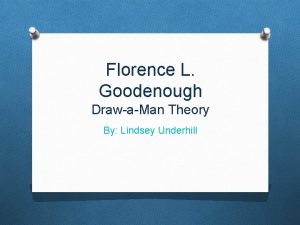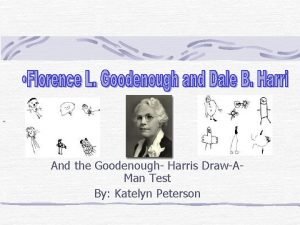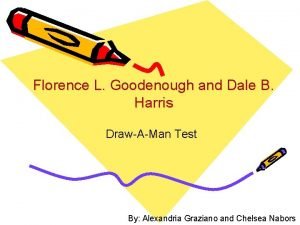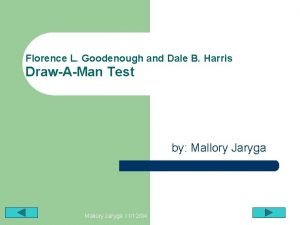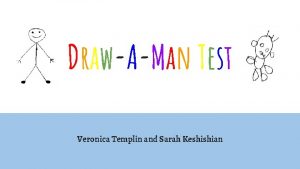DrawAMan The Gooden oughHarris Jessica Willi Drawing Te






















- Slides: 22

Draw-AMan The Gooden ough-Harris Jessica Willi Drawing Te amson Kane st

“The nature and content of children’s drawings are dependent primarily upon intellectual development. ” - Florence Goodenough “The child’s drawing of any object will reveal the discriminations he has made about that object as belonging to a class, i. e. , as a concept. ” - Dale B. Harris

Florence Goodenough • Born on August 6 th in 1886 in Honesdale, PA • Education o o 1908 – Bachelor of Pedagogy: PA Normal School 1920 – Bachelor of Science: Columbia University 1921 – Master of Arts: Columbia University 1924 – Doctor of Psychology: Stanford University • Worked with Lewis Terman at Stanford as he developed the Stanford-Binet intelligence test • Developed the Draw-A-Man test in 1926 o The test was designed to track the intellectual maturity and concept development of preand non-literate children • Revised the Stanford-Binet into Minnesota Preschool Scale • Criticized the use of Intelligence Quotient (IQ) to measure mental age • Published 9 textbooks, 26 research studies, numerous articles, and wrote a Handbook of Child Psychology • Died of a stroke in 1959

Dale B. Harris and his Contributions • Born in 1914 • Worked with Goodenough to publish his book • Revised and extended the Goodenough Test to include: o o Drawing a woman Drawing the self Standard score conversion table that can be normed Different scoring scales for male and female subjects • The Goodenough-Harris test has been used in new ways in the field of psychology o Personality tests o Effects of sensory loss o Children with learning differences

Introduction • The Goodenough-Harris Draw-a-Man test proposes that a child’s intellectual maturity can be gauged by evaluating his drawing of a man. o In the drawings of a child, a close relationship exists between concept development and general intelligence. • The drawings are assessed according to very specific criteria and a score is determined. o This score corresponds directly to the presence and accurate depiction of various elements of a drawing of a man. • Why a man? o Familiar, consistent, simple and complex, universal. • A child draws what he knows, not what he sees.

Proposal According to Goodenough, boys and girls of particular ages display qualitative differences in the drawings they make. Up to the age of twelve, girls generally show more attention to detail and score higher on the Goodenough-Harris test than boys. However, other investigations that inspect the drawing as a whole report a marked sex difference in favour of the boys. I am interested to see whether these results will hold for the drawings produced by children in kindergarten, 2 nd grade, and 4 th grade.

Important Terms • Cognitive development – the child’s development of perception, conceptualizing, knowing, judging, and reasoning • Concept development – the process of discriminating objects as belonging to a particular, identifiable class • Mental Age – the age to which a person’s intellectual maturity most corresponds, separate to their chronological or behavioral age • Raw Score – the total number of items scored as present and correctly depicted on the Drawing Test • Standard Score – the raw score converted to a specific, meanable scale

Hypothesis In this study I hope to find: • The drawings produced by the girls show greater attention to detail than the drawings produced by the boys. o There are more list items present in their drawings and they achieve a higher raw score. • The drawings produced by the boys have a greater sense of “whole” and completeness than those produced by the girls. o Although they do not show more list items or achieve a higher raw score, their drawings are complete and have additional features such as background or props.

Guiding Questions • Will the drawings produced in this study be congruent with the findings of the initial study performed by Goodenough (and confirmed by Harris) in the following ways: o The drawings produced by girls will have more details than those produced by the boys, and thus have a higher raw score. o The drawings produced by boys will have a greater sense of completeness than those produced by the girls. • What do the results of this study show about the cognitive and concept development of the boys and girls?

Data and Analysis • I tested a total of 16 children: o 2 boys and 2 girls from Kindergarten o 3 boys and 3 girls from 2 nd Grade o 3 boys and 3 girls from 4 th Grade • Each drawing was assessed to determine the raw score according to the Test Manual provided by Goodenough and Harris. • Each drawing was then assessed at my discretion according to “wholeness” and completeness. o The child's identity (Number) and chronological age (CA) were recorded, and the child was given a numerical value based on whether their drawing was complete, and whethere were additional features o 1 for positive results and 0 for negative results

Scoring • The Raw Score is determined by the presence and correct depiction of the items on this list • Total of 73 points • The Standard Score is calculated using a specific scale that expresses the child’s relative standing in relation to his or her own age and sex group. o With a calculated mean of 100 and a standard deviation of 15.

4 th Grade

2 nd Grade

Kindergarten

Score Comparisons - Standard Males Females 160 Standard Score 140 120 100 80 60 40 20 0 10 10 9 8 8 Chronological Age 7 6 5

Score Comparisons - Averages Males Females Average Standard Score 130 129 125 120 125 123 121 115 120 116 110 105 100 4 th 2 nd Grade Level K

Wholeness Comparisons Males Females Number CA Complete Features Sum 2 10 1 1 2 5 10 1 6 10 1 3 10 1 4 9 1 1 2 1 9 1 0 1 9 8 1 0 1 12 8 1 0 1 13 8 1 0 1 10 7 1 0 1 8 7 1 1 2 11 7 0 0 0 18 6 1 0 1 20 5 0 0 0 19 5 1 0 1 21 5 1 0 1 Wholeness: 11 1 = Positive Wholeness: 0 = Negative 6

Scoring Results • According to the data for Standard Scores, only half of the girls scored higher than the boys. o At least one girl from each age group scored higher than the boys in her age group. • According to the data for the calculated averages, the girls scored higher than the boys. o In two out of the three groups assessed, the average score for the girls was significantly higher than the boys’. o In the case where the boys scored higher, the discrepancy was only 2 (two) points.

Wholeness Results • According to the data, the boys’ drawings showed more completeness than the girls’. o Every boy produced a complete drawing, whereas two of the girls had incomplete drawings. • They also showed more instances of features such as background or props. o Three of the boys had additional features present in their drawings, whereas none of the girls did. • Overall, the boys’ drawings had almost double a sense of “whole” and completeness.

Conclusions My hypothesis that girls would score higher is correct. • This confirms Goodenough and Harris’ findings that up to the age of twelve, girls generally show more attention to detail in their drawings. • However, boys were not far behind in their scores. This means that both sexes are at the same approximate level of concept development. My hypothesis that the boys’ drawings would have a greater sense of “whole” and completeness is correct. • This confirms the findings that up to the age of twelve, boys produce a more complete drawing. • The wholeness of the boys’ drawings compensates for their lower scores, which reiterates my conclusion that both sexes are at the same approximate level of concept development.

Limitations and Revisions I encountered the following limitations: • Small and limited sample groups o I managed to assess only three or two drawings from each age and sex group, which substantially limits the data. o The students assessed represent a limited group of our society. • Inexperience with scoring the drawings o I did not have a lot of time to practice scoring, and so the results I got could be inaccurate. If I were to perform the test again, I would: • Expand the sample groups to include children from different socio-economic background, schools, and groups of society. • Practice with more drawings!

Where do they stand? I believe that Goodenough and Harris fall on the Nature. Nurture continuum in the following way: Nature Rousseau Nurture Goodenough & Harris Intelligence is a stable entity Concept development is not something that can be taught Locke
 Jessica gooden
Jessica gooden Gooden
Gooden Willi sauerbrei
Willi sauerbrei Prada willi
Prada willi Willi merny
Willi merny Willi gofron
Willi gofron Prader willi syndrome
Prader willi syndrome Prader willi syndrome symptoms
Prader willi syndrome symptoms Sindrome di prader willi
Sindrome di prader willi Sap supplier lifecycle management
Sap supplier lifecycle management Sindrome de prader willi
Sindrome de prader willi Willi steul
Willi steul Judith kuster
Judith kuster Ruedi willi sap
Ruedi willi sap Mutaciones genicas
Mutaciones genicas Prader willi sündroom
Prader willi sündroom Willi noack
Willi noack Chó sói
Chó sói Thiếu nhi thế giới liên hoan
Thiếu nhi thế giới liên hoan Fecboak
Fecboak điện thế nghỉ
điện thế nghỉ Một số thể thơ truyền thống
Một số thể thơ truyền thống Thế nào là hệ số cao nhất
Thế nào là hệ số cao nhất
